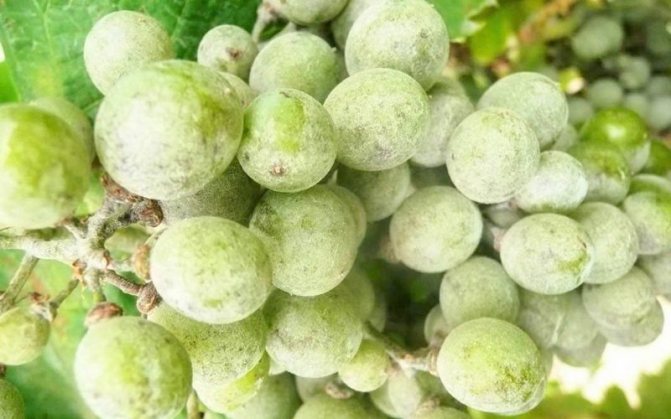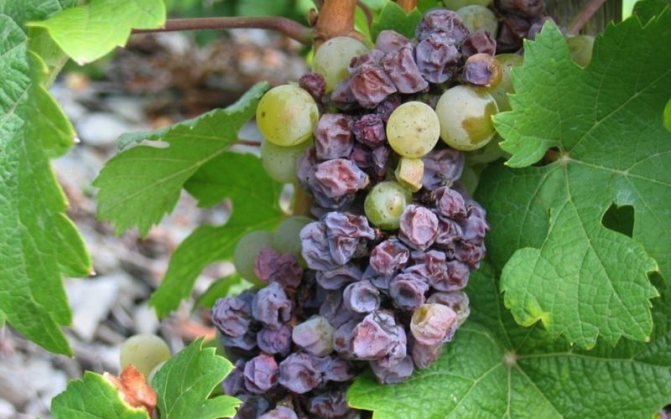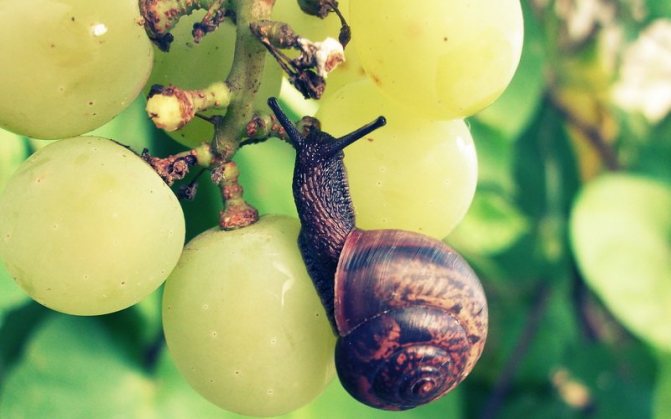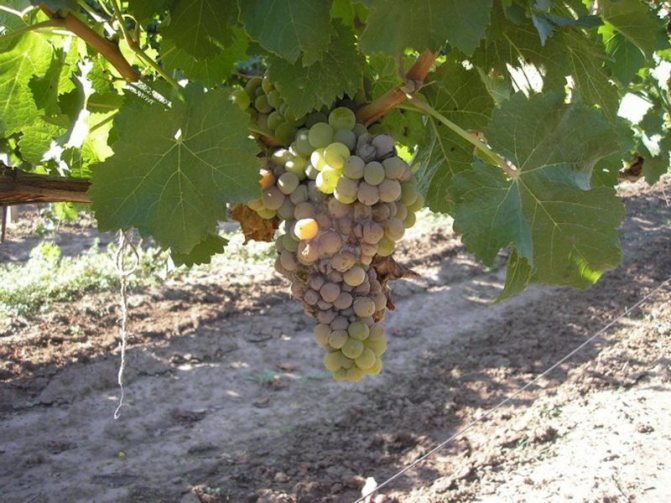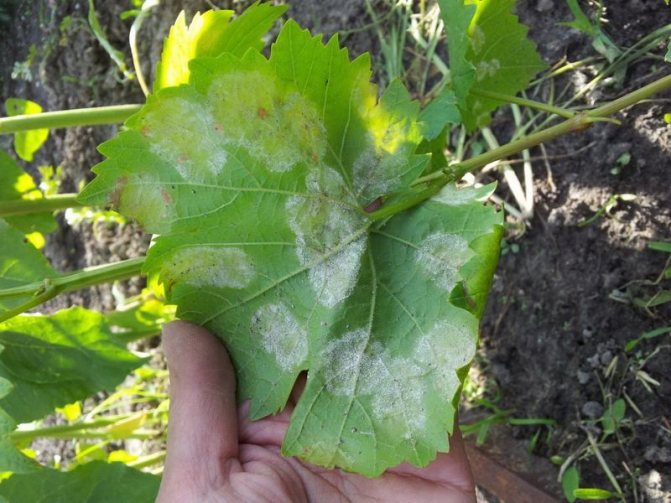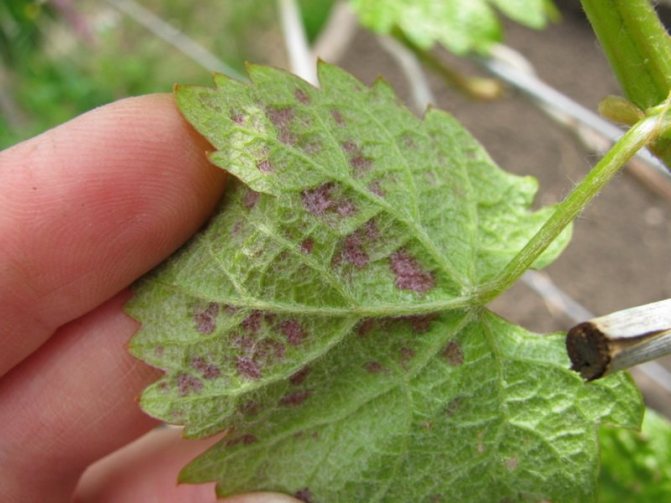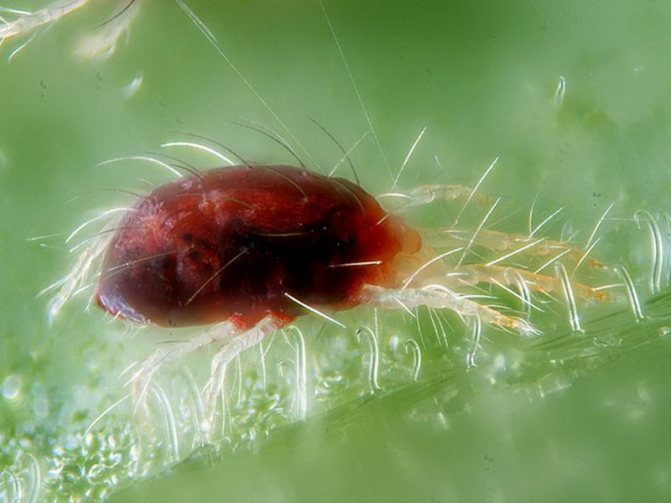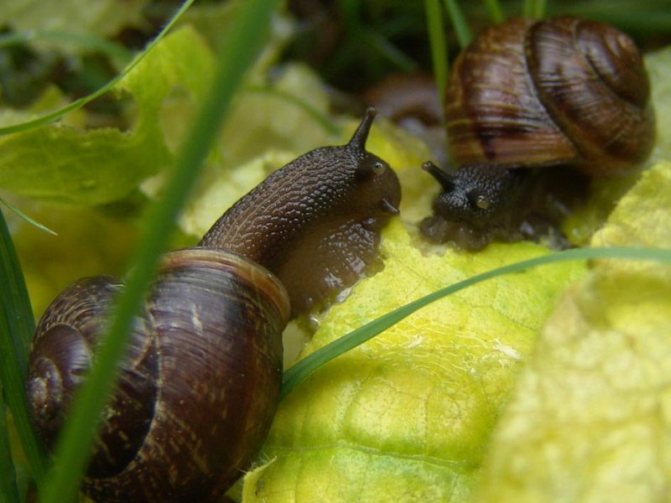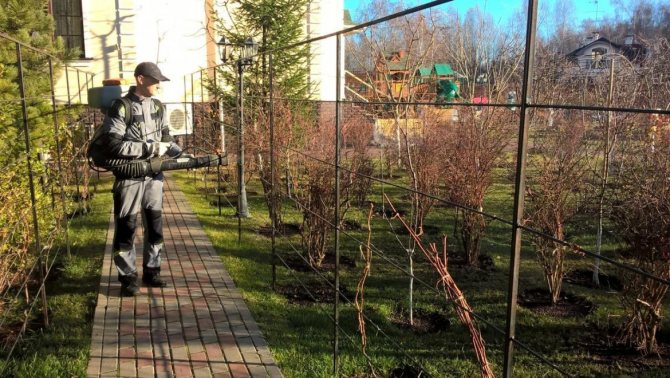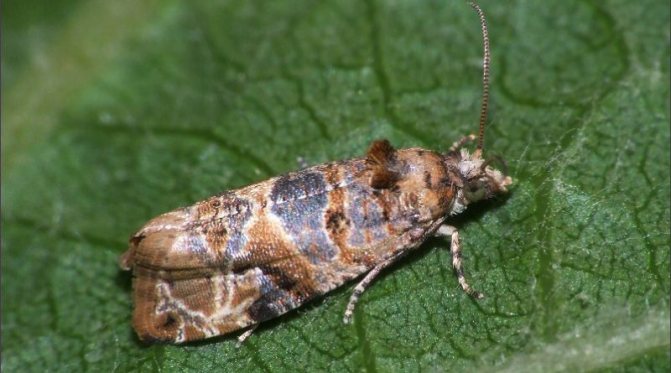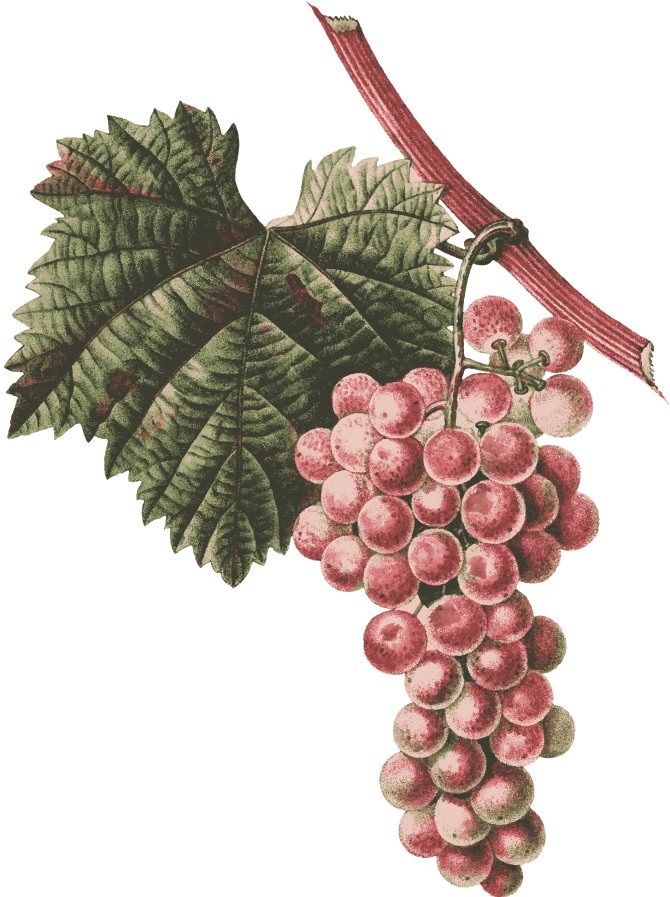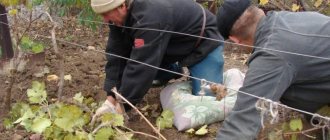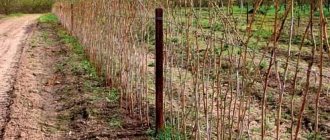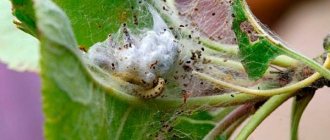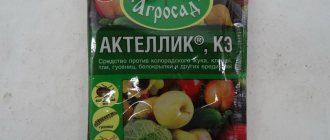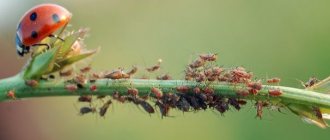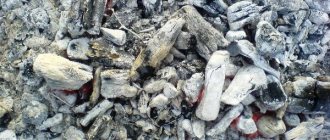When to spray grapes from pests and diseases: the optimal time for processing the vines
The first spring treatments of grapes are carried out before the buds swell. Usually the buds open in late April - early May. It should be borne in mind that the timing differs depending on the region and weather conditions, so it is important not to miss the moment.
The first prophylactic spraying of grapes is carried out at a temperature of 4-6 ° C. During this period, grape bushes are treated with a 3% solution of copper sulfate to protect them from diseases and rodents. If last year the vine suffered from diseases and pests, it is highly undesirable to skip this procedure.
Grape processing can be started only after you put in order the aisles and cut off all diseased shoots and leaves.
After about 2 weeks, when 4-6 young leaves are formed on the vine, it can be treated with a fungicide. To do this, dilute 200-300 g of Nitrafen in 10 liters of water and spray the bushes with the resulting solution.
The most common grape diseases are mildew (downy mildew) and oidium (powdery mildew). Mildew is fought with copper-containing preparations (3% copper sulfate, Azophos). Sulfur-containing preparations (colloidal sulfur, Cumulus, complex preparation Quadris) are used for grape oidium.
The last spring treatment for the prevention of these grape ailments is carried out about 1-2 weeks before flowering, from late April to mid-May (depending on the climate).
If you notice a grape mite on the vine, urgently use acaricides (Aktellik, Tiovit Jet, etc.). This treatment is carried out in the phase of 9-12 leaves (of course, until flowering has begun).
When the berries on the vine grow to the size of a pea, it is advisable to treat the grapes again for fungal diseases. You can use Topaz or Ridomil Gold fungicides. After that, every 3 weeks spray the vine with Quadris or Flint Star antifungal drugs until the 10th of August.
If symptoms of gray rot occur, spray the bushes with a pink solution of potassium permanganate (5-7 g of potassium permanganate per 10 liters of water).
The obvious symptoms of gray rot are brown spots, gray bloom on the leaves, and discolored spots on the vine.
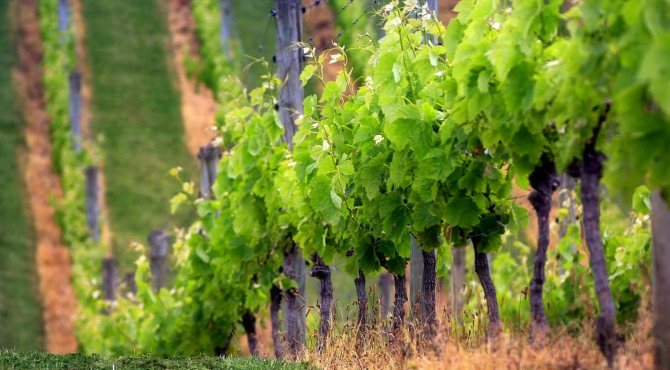
If you suspect powdery mildew, treat bushes that still have clusters with colloidal sulfur or potassium permanganate. Treat bushes that you have already harvested with Flint Star or Strobe.
In the middle of summer, it is important to treat grapes with fungicides.
In dry weather, after pruning the vine, you can carry out preventive treatment of the grapes. As a preparation, you can use a 3% solution of ferrous sulfate.
The advantage of autumn processing is that the treated grape vine does not suffer as much from rodent infestations. Iron vitriol also protects grapes from fungal diseases.
To prevent rodents from reaching the grapes, poisoned baits (Storm, Tricota, Blockade, etc.) can be laid next to the grape bushes.
After that, you can safely start covering the bushes for the winter.


In preventive treatments of grapes, it is important not to confuse the timing of spraying with iron and copper sulfate.
Iron vitriol is not suitable for spring treatments, since it inhibits the opening of eyes. Therefore, in March-May, preference is given to copper sulfate.
But for the autumn treatments of the grapevine, iron sulfate is perfect.
After rain, in warm weather, the risk of disease in the vineyard with such fungal diseases as anthracosis, gray rot, white rot, mildew increases.
Anthracnose
A fungal disease that affects all green parts of grapes, young tissues are especially susceptible. Its appearance is evidenced by small brown spots with a dark white border, which subsequently increase and merge, after which they dry out and die off. Shoots also suffer from the disease, they are covered with necrotic depressed spots of brown color. The tissues affected by the fungus crack, forming deep ulcers. The stems become brittle, break and dry out.
Gray rot
The fungus prefers the green parts of the grapes. Symptoms of the disease are brown spots on the foliage, covered with bloom, necrosis of the tissues of tree shoots, drying out of inflorescences, bunches, the acquisition of the skin of the fruits of a brown color and a loose state.


To protect the vineyard from gray rot, spray with Dnok until the buds open. During the growing season, use "Ortoftapan". After harvesting the grape storage area, fumigate with sulfur.
White rot
Fungal disease affects green fruits in damp, warm weather. You can diagnose white rot by the appearance of off-white bulges on the berries and their wrinkling and drying.
The weapon against the fungus is a 3-4% Bordeaux liquid, which needs to be sprayed on the plant. Repeat the procedure after rains, when symptoms of damage appear.
Mildew
Mildew is considered one of the most dangerous diseases of grapes, which affects all parts of the plant. This downy mildew occurs after rains, so its development is mainly observed in conditions of frequent precipitation in summer. At high humidity, the spores of the fungus move in drops of water and are embedded in the tissues of the grapes.
The disease is diagnosed according to the following symptoms:
- the appearance on the outer surface of the leaves of transparent spots up to 3 cm in diameter, painted yellow;
- the presence of a velvety white bloom after precipitation in the form of rain, dew, fog;
- inhibition of the growth and development of grape bushes;
- falling foliage;
- darkening of the fruit - they acquire a blue and brown color and shrivel.
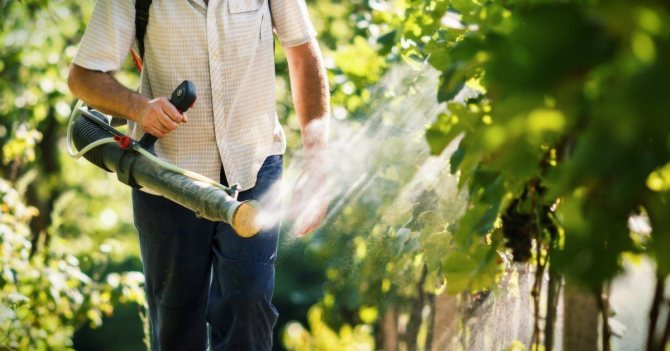

To prevent mildew, preventive spraying with 1% Bordeaux liquid should be carried out at the end of the rain, until the spores have penetrated into the plant tissue. Also, for protection, you can use suspensions such as copper oxychloride (0.5-0.8%) and "Tsineb" (0.5-0.7%).
Preventive measures consist in carrying out operations and techniques that will help not only multiply the harvest, improve the quality of berries, accelerate the ripening of fruits, increase the elegance, but also protect against dangerous pests.
Weeding
Timely weeding will help reduce the moisture level in the lower part of the grapes and prevent the development of diseases.
Pruning
Proper pruning will create favorable conditions for good aeration and sufficient illumination of all parts of the plant.
When cultivating grapes, you need to constantly inspect the plant and promptly remove all parts affected by pests, followed by burning them away from the site.
Proper watering
It is important to properly organize watering, optimally moisturizing the soil and maintaining it in the condition necessary for the good development of the grapes.
Advice! Water carefully under the root, avoiding moisture on the leaves of the crop.
Mulching
A mandatory procedure is mulching the soil around the vines.Humus or crushed parts of conifers can serve as mulch. This will allow you not to dig up the soil and not disturb the top layer, in which the spores of the fungi are concentrated.
Top dressing
The introduction of nutrients will strengthen the immunity of grapes and increase its resistance to various fungal diseases.
The main pests that appear on grapes are aphids (phylloxera) and spider mites. Chemical preparations have been developed to combat aphids:
- fastak, contact-gastric action on parasites;
- fosalon, characterized by long-term action;
- actellic, lasts up to 2 hours, prevents the reappearance of aphids;
- kinmix, destructive for both adults and larvae
To combat spider mites, fosalon, benzophosphate, permethrin are used. Any pests, including spider mites, die after spraying with a solution of colloidal sulfur (75%).
I try not to use chemicals and use folk methods. Against aphids, I use an infusion of potato or tomato tops. Take 1.5 kg of chopped tops per 10 liters of water and infuse for 3-4 hours. Spraying with wood ash also helps well (1 glass of ash per 5 liters of water, infused for 12 hours).
Gives an effect and soap solution (100 g of tar soap in a bucket of water). And from the tick I prepare an infusion of onion peel as follows: I fill a jar (the volume depends on the required amount of infusion) with onion peel halfway, fill it with hot (60–70 ° C) water, leave for 1–2 days. After straining, I dilute it twice with water and use it immediately.
When performing spraying of grape bushes, so-called tank mixtures are often used in order to save time and labor costs. In this case, two preparations are diluted in water. One is a fungicide and the other is an insecticide. With this treatment, they simultaneously fight against fungi and pests of the vine.
Tank mixes can be chemical or biological.
- Skor plus Aktara. Thanks to the first component, grapes are cured of phomopsis, oidium, rubella and rot. And thrips and leafhoppers will suffer from the second component.
- Ridomil Gold plus Topaz. The first component is directed against mildew, and the second heals from mildew.
- Ridomil Gold plus Topaz plus Aktara. This three-component tank mix will get rid of:
- mildew;
- oidium;
- thrips;
- leafhoppers.
- Ridomil Gold plus Tiovit Jet. The first component will suppress mildew, and the second is directed against ticks and powdery mildew.
- Ordan plus Tiovit Jet. Ticks will suffer from such an explosive mixture, and plants will be cured of mildew and oidium.
- Cabrio Top plus Caesar. The first remedy will suppress oidium and mildew, and the second remedy will exterminate the bunchworm and mites.
- Aktofit plus Bitoxibacillin plus Guapsin. It is a three-component tank mixture against pests and fungi. Effective against ticks and other harmful insects, as well as against pathogenic fungi.
- Fitosporin plus Bitoxibacillin. The first component is a fungicide and the second is directed against insect pests.
- Fitoverm plus Bitoxibacillin plus Gaupsin. This three-component tank mixture is aimed at destroying harmful insects and pathogenic fungi.
- Lepidocide plus Bitoxibacillin plus Gaupsin. This explosive mixture simultaneously suppresses some insects and pathogenic fungi.
Pests
Grapes have many enemies. This is also unfavorable weather conditions: severe frosts in winter and frequent rains in summer. Hail and drought, disease. But bushes and grape pests also pester. They are so small that it takes some skill to examine them and understand what is gradually undermining, it seemed, such a viable bush. Among the most common pests of grapes:
- Phylloxera. Damages the root system. The pest is a barely noticeable greenish-yellow aphid.Signs of the disease: swelling on the lobes of young roots, in appearance resembling light yellow curved beaks. On old roots, significant tumors are formed in the form of nodules. Both leaf and root phylloxera are carried by the wind. This can be up to 10-12 kilometers;


The leaf form of phylloxera damages the aboveground mass of horticultural crops and vineyards, settling mainly on leaves and young shoots.
- Wireworm and winter scoop... Wireworm larvae bite into grape shoots that are underground and dry out. Caterpillars of winter moths gnaw young shoots and leaves;
- Larvae of marbled and hairy beetles. They mainly operate on sandy soils, gnawing through the underground trunk of seedlings;
- Spider mite. Leaves are damaged. Those bulge, turn yellow and fall off. At the same time, the vine does not ripen;
- Two-year leaflet. Caterpillars gnaw at not yet blossoming inflorescences, berries and this causes their decay;
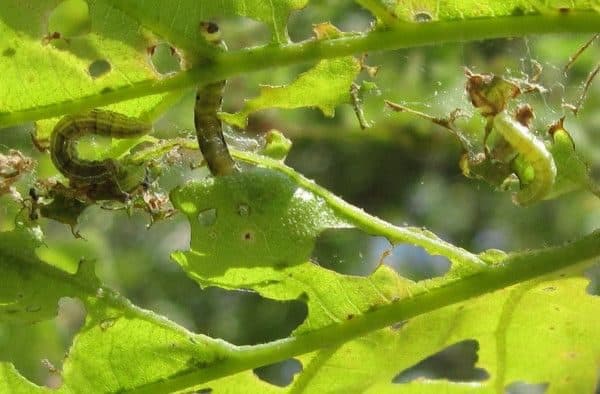

Leaf rollers actively destroy buds, flowers and grapes.
And there are also pests: grape flea and moth, goldfish, odorous woodworm, wasps, etc.
Why do you need to process grapes
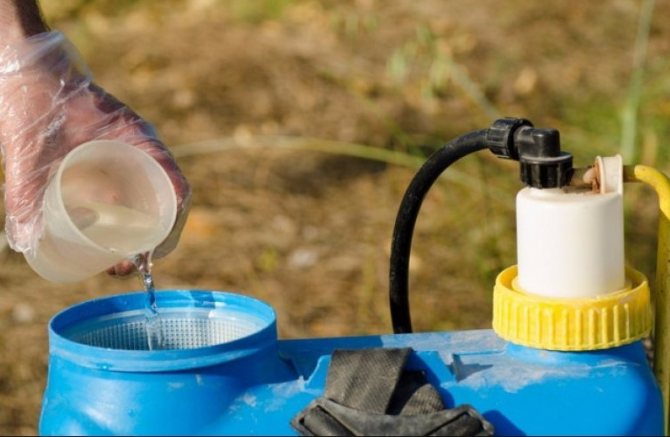

Bacteria, fungi and pests can degrade the taste of berries, reduce and sometimes destroy the entire long-awaited crop and even the entire plant. It is always easier to prevent a disease than to fight it later. To combat diseases of grapes and harmful insects, it is necessary to carry out preventive treatments of the vine. And, of course, when a specific problem is detected, urgently take measures to eliminate it.
The most harmful diseases of grapes are mildew, or downy mildew, and powdery mildew, or powdery mildew. This "dusty couple" of fungal diseases affect leaves, shoots, inflorescences and berries, they are especially dangerous for the sweetest European grape varieties.
grapes affected by mildew have light yellow spots on the upper part of the leaves; mildew-affected berries are covered with a white powdery coating powdery mildew affects the leaves, they become covered with a gray coating, curl and dry out, the berries affected by mildew crack
Fungal diseases are also such as anthracnose, various types of rot, spotting, fusarium and others. With the help of the wind, spores are carried over long distances, reach the surface of plants, germinate and give new spores. It is quite difficult to stop the onset of infection.
Many bacterial diseases are poorly treatable and can lead to the death of the bush. The most common of these are bacterial spotting, necrosis, and cancer.
Some diseases are caused by insects that live on leaves and trunks. The most dangerous of them are aphids, phylloxera, leafworm and spider mites. The spider mite manifests itself as red-red balls on the veins on the underside of the leaf, it very noticeably inhibits the growth of young shoots.
That is why preventive treatment of plants comes first.
In the fight against diseases and pests of grapes, along with the long-used iron and copper sulfate and Bordeaux liquid, many new fungicides have appeared. For their correct use, you should know that fungicides are:
- contact action;
- systemic action;
- combined
Contact fungicides are not addictive, but their effectiveness is highly dependent on the thoroughness of application, they act on the surface of the plant and are dependent on weather conditions and the time of application, the first rain will wash them away, and dew will reduce the effect. They can be compared to topical preparations and can be repeated regularly.
They should be used for prevention or at the very beginning of the disease. Contact fungicides include Omal, Rowright and Bordeaux liquid. Systemic fungicides act as if from the inside on the whole plant, the result from their application is immediately noticeable, and the rain will no longer wash them away.Their disadvantage is that they are addictive, they need to be changed regularly, they are usually used after flowering.
As you know, any problem is easier to prevent than to solve later. Therefore, so that the plant does not suffer from misfortunes, it is better to strictly follow the established processing schedule in spring and summer.
Naturally, in order to understand what kind of preparation to spray grapes, you need to know its enemies "by sight".
Diseases
The vine is susceptible to the following fungal diseases:
- mildew (downy mildew, yellow spots);
- oidium (powdery mildew, white spots);
- anthracnose (brown and brown spots);
- phomopsis (black spot, excoriasis, dry arms);
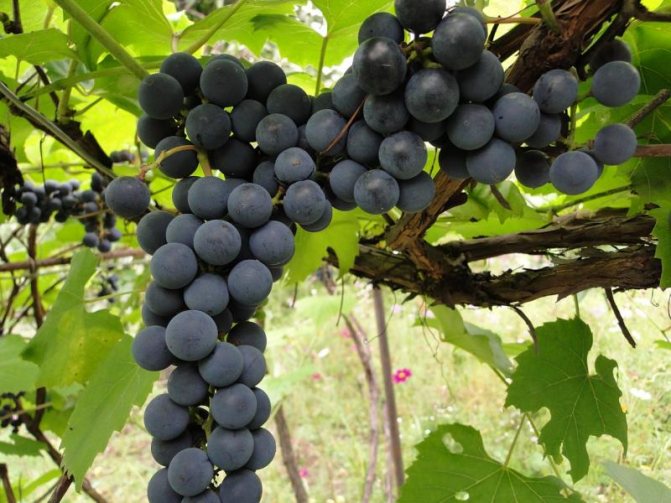

Thus, all fungal diseases are characterized by the formation of abnormal spots and growths of different colors and sizes.
- After removing the shelter and the garter to the trellises (along the bare branches) = during the period of swelling of the kidneys.
- Dissolving buds and formation of leaves.
- Formation of inflorescences (budding).
- During flowering (optional).
- Formation of berries (after flowering, when the berries are the size of a "pea").
- During ripening (but before harvest).
- After harvest (in autumn).
And in the following videos, hobby gardeners share their own vine spraying patterns throughout the season.
Now for spring spraying the garden, there are many different tools that will help you effectively cope with any pests and diseases. But in order to know exactly when and how to use them, you should understand what their features and differences are.
So, for effective spring processing of grapes, you will need:
- fungicides (drugs to fight diseases);
- insecticides (insect pest control agents);
- insectofungicides (complex preparations acting simultaneously against pests and diseases).
Moreover, these funds (fungicides and insecticides) can be:
- chemical origin (chemicals);
- biological (biological products).
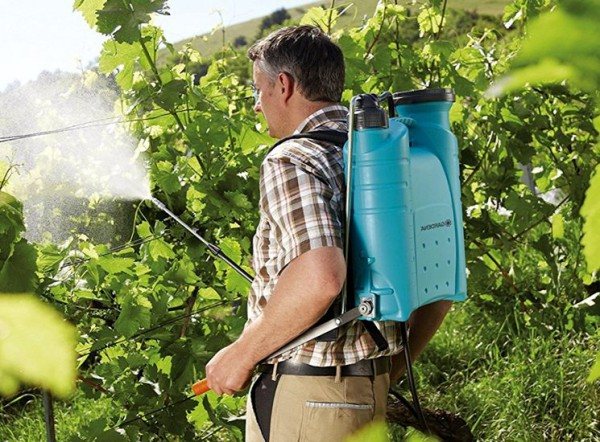

Unlike biological products, chemical agents act much faster and more reliably. In addition, the use of "chemistry" is often vital, the only way to cure (more precisely, save) the culture from fungal diseases and get rid of annoying pests.
The treatment of grapes with chemical agents in spring does not have any negative consequences for the future harvest and human health, since after the waiting period all pesticides (including chemical ones) are completely removed.
It should be understood that biological drugs and folk remedies are more gentle, which is permissible in the following cases:
- with a small number of pests;
- at the initial stage of development of a fungal disease or with a mild infection, as well as as a prophylaxis.
Naturally, it is fundamentally important to be able to determine, according to the state of your grapes, which drug should be used.
- If you have recently sprayed grapes, the leaves are clean, without signs of disease, then it is better to use preventive (protective) drugs.
- If you notice signs of the disease, even if only on some leaves, then you already need to use drugs with a therapeutic effect.
Systemic drugs are "absorbed" by the plant and act from the inside, so, by and large, it is not very important to treat the entire leaf surface. Also, some systemic drugs transfer their active substance to the tops of the vines, thus protecting the growing points from diseases.
Contact drugs only work where you put them. Therefore, where you do not apply them, the disease will remain, it will not go anywhere. This is why this processing must be done very carefully.
- Bordeaux mixture (3% solution of Bordeaux liquid - before bud break, 1% solution - before flowering, from mildew - downy mildew and anthracnose);
- Copper sulfate (3% solution, from mildew - downy mildew);
- Abiga-peak (contact fungicide of protective action based on copper oxychloride, from mildew - downy mildew);
- Hom (contact fungicide of protective action based on copper oxychloride, from mildew - downy mildew);
- Oxychom (fungicide of contact-systemic protective action based on copper oxychloride and oxadixil, from mildew - downy mildew);
- Cuprolux (Copper oxychloride and Cymoxanil, systemic contact fungicide of protective and curative action, against mildew);
- Tiovit Jet (contact fungicide of protective action based on sulfur, against powdery mildew and mites, spray during the entire growing season);
- Colloidal sulfur (contact fungicide of a protective action, against powdery mildew and mites, spray during the growing season);
- Ditan (contact fungicide of protective action based on mancozeb, against mildew - downy mildew);
- Delan (contact fungicide of protective and curative action based on dithianon against mildew - downy mildew);
- Cabrio Top (Metiram (Polycarbocin) pyraclostrobin, a protective contact fungicide, against mildew and oidium);
- Skor (systemic contact fungicide of protective and curative action based on difenoconazole, against powdery mildew, phomopsis - black spot, rubella and various rot);
- Raek (systemic contact fungicide of protective and curative action based on difenoconazole, against powdery mildew, phomopsis - black spot, rubella and various rot);
- Fundazol (systemic contact fungicide of protective action based on benomyl, from powdery mildew, gray rot, spray during the growing season);
- Topaz (a systemic fungicide of a protective action based on penconazole, from powdery mildew, spray it during the growing season when the first signs of the disease appear);
- Ridomil Gold (systemic contact fungicide of protective and curative action based on mancoceb and mefenoxam, against mildew - downy mildew);
- Quadris (systemic contact fungicide of protective action based on azoxystrobin, against mildew - false and mildew - powdery mildew, spray during the growing season before and after flowering);
- Pergado (systemic contact fungicide of protective and curative action based on mandipropamide and copper oxychloride, against mildew - downy mildew, spray during the growing season);
- Dinali (systemic contact fungicide of protective and curative action based on difenoconazole and ciflufenamide, against powdery mildew and black rot, spray during the growing season in the phases: budding-flowering, until the berries close in a bunch and with an interval of 10-15 days) ;
- Switch (a systemic fungicide of a protective and curative action based on cyprodinil and fludioxonil, against gray and white rot, as well as a complex of berry rot: olive, moldy, black Aspergillus, watery rhizopus, spray during the growing season in the phases: end of flowering, before the berries close into bunches, the beginning of coloring of berries);
- Horus (a systemic fungicide of protective and curative action based on cyprodinil, against gray and white rot, as well as a complex of berry rot: olive, moldy, black Aspergillus, watery rhizopus);
- Acrobat MC (Mancozeb Dimethomorph, systemic contact fungicide of protective and curative action, against mildew - downy mildew);
- Acrobat Top (Dimethomorph Dithianon, systemic contact fungicide of protective and curative action, against mildew - downy mildew);
- Thanos (Famoxadon Cymoxanil, systemic contact fungicide of protective and curative action, against mildew);
- Falcon (Spiroxamine Tebuconazole Triadimenol (Baytan), a systemic fungicide of protective and curative action, against powdery mildew);
- And other contact and systemic fungicides of a wide spectrum of action.
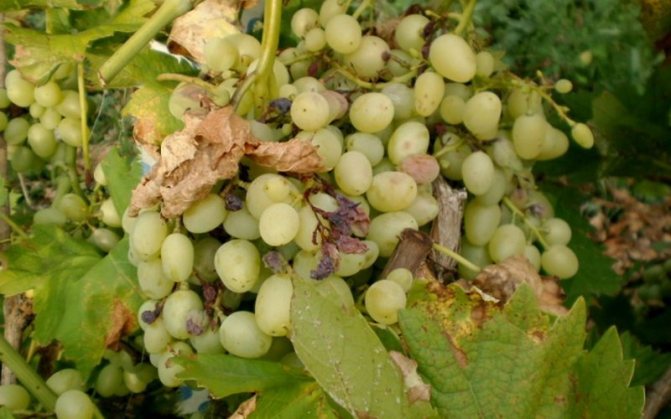

Grape disease in the photo
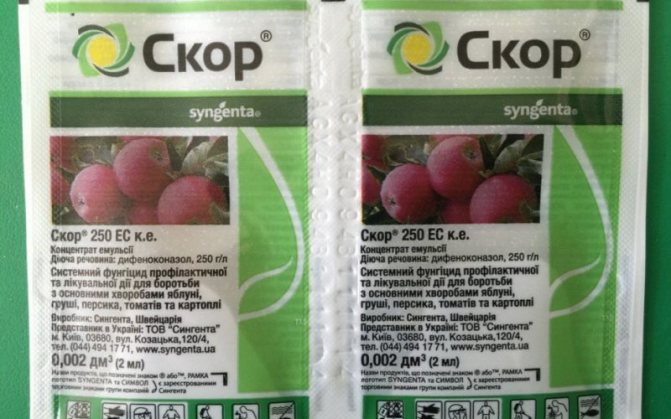

Means of protection for grapes "Skor" in the photo
Disease Resistant Varieties
Recently, hybrids that are resistant to certain diseases have appeared. At the same time, it may be highly resistant to mildew, but susceptible to anthracnose. Much more depends on the climatic indicators of the area of cultivation of crops, soil, condition of seedlings. So, on the southern coast of Crimea, grapes are not affected by mildew every year, in contrast to regions located at the same latitude. Therefore, the reduced susceptibility of some varieties to diseases does not mean that prophylactic treatments should not be carried out.
These varieties include:
- Timur;
- Rochefort;
- Harold;
- Delight;
- Carmenere.


Hybrid varieties are highly resistant to certain pathologies.
Preparation of tank mixes
Please note that it is possible to carry out combined treatments of grapes, that is, spray the vine with several drugs at once for various diseases at the same time. This "cocktail" is called a tank mix.
To prepare the correct tank mixture, the recommended dose of each drug is first diluted in a small amount of water, then added to the general container. In this case, different drugs must be dissolved in different containers.
The amount of water is not cumulative! For example, if, according to the instructions, each of the drugs must be diluted in 10 liters of water, then the total volume of water in the tank mixture should be 10 liters. That is, if you previously diluted 2 drugs in 2 liters of water, you need to pour the resulting solutions into 8 liters of water, so that in the end the volume of the entire tank mixture is equal to the declared 10 liters.
We also recommend that you keep a visual Grape Care Calendar, which will help you not to miss the timing of fertilizing, pruning and processing.
Work calendar
Also, growers use an alternative grape processing scheme - according to the calendar. According to her, vineyards are processed according to the seasons: spring, summer and autumn.
Spring
Spraying dates in spring according to the calendar:
- April 1-10. Treatment with 1% ferrous sulfate solution. Protection against fungus and delayed bud opening.
- April 20-30. Inspect buds that open for pests. If present, spray with insecticide. In the absence of parasites, treat with a fungicide.
- May 1-30. Spraying with fungicides and insecticides against mildew, mites, leafworm and powdery mildew.
These processing steps should be taken especially seriously if the vineyards were affected by diseases in the last season.
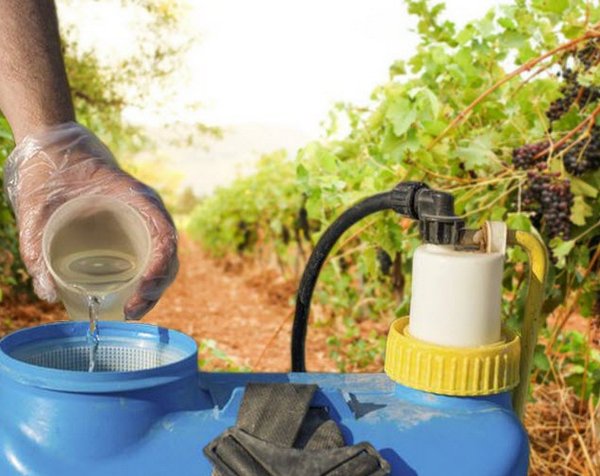

Summer
June 1-10. Treatment against ticks, leaf rollers and phylloxera.
If necessary, in July, you can carry out additional treatment against ticks (if the weather is dry and hot) and take measures to scare away wasps and bees (if too many of them threaten the harvest).
Fall
From 1 to 20 September. At this time, the bushes are treated from wasps, mildew and insect pests.


Important! Before harvesting, it is necessary to carry out preventive spraying with biological preparations so that the grapes do not accumulate toxic substances in their fruits.
In late October - early November, the vine is prepared for winter.: pruning bushes, removing leaf litter, weeds and crop residues, and preparing a winter shelter for grapes.
When the average daily temperature drops to -2 ° C, the vine is treated for the last time this season with a 1% solution of ferrous sulfate and covered for the winter.
Treatments and methods for controlling insects
The main reason for the appearance of brown spots on grape leaves is various diseases. Treatment methods depend on the type of pathogen, each case is individual.
Important! The basic rule is that treatment should be started as soon as symptoms are detected. Delay can lead to serious consequences.
Fungal diseases
The most common causes of brown spotting are fungal diseases, which are treated with contact or systemic copper-containing fungicides.
Note! Everyone knows that the disease is easier to prevent than to cure, therefore, for the purpose of prevention, vineyards are treated with fungicides immediately after harvest and leaf fall.
If the degree of damage to the bush is large, then it is compulsorily burned to avoid an epidemic.


